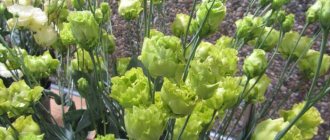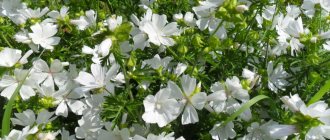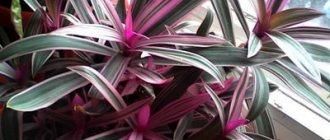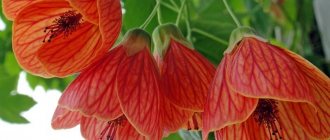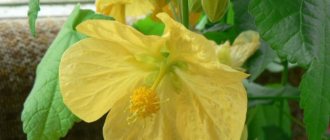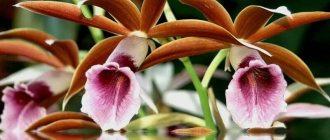Plants with black flowers are a rarity when decorating the interior of a home or garden. But at the same time, such flowers look graceful, slender, elegant and are considered symbols of rebirth, the beginning of a new life and farewell to old diseases and problems. Black flowers become real highlights in the interiors of housewives, creating a sophisticated atmosphere of severity and beauty. Monochrome black gardens contrast perfectly with the greenery on the site and look attractive, fascinating and extremely unusual.
Black flowers: history, meaning and modern floristry
Traditionally, the color black is identified with mourning, longing and sadness. Most often, black flowers are presented at funerals or wakes - to a person who has suffered great grief.
Widow, mother, bereaved child or other close relatives. These flowers are a sign of sympathy and consolation for the loss of a loved one.
It is not customary to give black flowers to a person without such a reason, otherwise they may be mistaken for wishing something bad. However, recently there has been an increasing tendency to use black flowers in bouquets.
- Florists put a different meaning into black flowers - rebirth, farewell to old habits, illnesses and the path to a new happy life.
After all, in ancient times, black was a symbol of fertility, peace and a penchant for knowledge.
Many centuries ago, black flowers symbolized winter, followed by green spring and red summer. And black became the color of mourning much later, not so long ago.
- Therefore, if you want to give someone black flowers, a composition using black flowers or leaves, then do it correctly.
- Do not give black flowers to young girls; pink and white flowers are better for them
- Do not give black flowers to all women over 35 years old, 99% of ladies will perceive them as a hint of fading and fading youth
- Black flowers in a wedding bouquet mean that a girl is getting married under duress, without love.
However, not all people like black flowers for various reasons. For us, a black flower is another form among the countless diversity of the plant world.
Moreover, the form is amazing and memorable. We hope that you can see this for yourself by looking at the photographs.
Anthurium
A beautiful and unusual tropical plant, anthurium is often grown in homes and greenhouses. Its varieties Black Queen, Black Paris, Black Love, thanks to the efforts of breeders, have black flowers.
The plants have thick, shortened stems. Leaves may be multipinnate or heart-shaped. They are painted in a rich green color, sometimes a burgundy tint predominates. Anthurium reaches a height of 50–80 cm.
The plant has a unique flower shape. It is a flat or slightly curved bract of a round shape with pronounced veins and a cone-shaped spadix located vertically.
The flower size is about 13 cm. The glossy bract is burgundy or cherry in color, but over time it darkens and becomes black.
Anthurium needs regular watering, but does not tolerate stagnant moisture in the soil. For this reason, the root system of the plant may begin to rot, and the leaves will turn black around the edges.
Garden black flowers: 10 popular
1. BLACK PETUNIA - Black Velvet Petunia.
According to authoritative experts, this variety has become the pinnacle of breeding work of British gardeners. This variety of petunia became the first flower to be truly black, rather than dark burgundy or dark purple.
The creators of the variety claim that black petunia does not contain any genetic modifications, but achieved this result through special pollination.
- Petunia has amazingly black and velvety flowers that blend beautifully into any floral arrangement.
Now landscape designers and florists have an amazing and unusual tool in their arsenal. The specific color of the flower made it popular in a short time, because people love everything unusual and inaccessible.
- Bush upright petunia about 20-30 cm high, black velvety flowers about 8 cm in diameter. Propagated only vegetatively (by cuttings). It is recommended to plant in sunny areas. Withstands temperatures down to zero degrees Celsius.
Petunia
2. CALLA BLACK
Black callas amaze at first glance with their elegance and mystery. Although they are not pure black, but closer to maroon and deep purple, they are still stunning and stunning.
These plants are much less common than those with white coloring. Flower growers and florists from all over the world awaited the appearance of black calla lilies with great impatience.
Couples in love especially love them, as a sophisticated symbol of passion and elegance. Another popular opinion among experts is that black callas symbolize negativity and farewell to someone.
Therefore, black calla lilies are recommended to be used more as an interior element. Black callas instantly attract attention and add style to the room. A bouquet of black callas in a vase on the table instantly adds special chic to the table on which they stand.
Calla lilies
3. BLACK LILY
A delightful and dazzlingly beautiful black flower. The black lily is a real pearl of any flower collection.
- Fortunately, in our time, anyone can own this black flower. In terms of care, lilies are not particularly different from their relatives of any other color.
SEE ALSO: FLOWERS LIKE LILIES - 15 PLANTS!
Lilia Landini
4. ROSE BLACK
Of course, we couldn’t ignore the classic black flower. The black rose has been bred for quite some time and is successfully grown all over the world.
There are quite a large number of varieties of black roses, among which are: Black Diamond, Black Magic, Halfeti.
The Turkish black rose Halfeti is gaining popularity and becoming more accessible every day. A black flower can be ordered to any corner of our planet from an official representative.
In the world of floristry, there is no exact and clear meaning of a black rose. Several meanings are used at the same time, so that if you like black flowers and want to have them, this is the main criterion when deciding on a purchase.
WE RECOMMEND READING: HOW TO DRY A WHOLE ROSE, SEPARATELY A BUD OR PETALS?
Rose
5. TULIP BLACK
Another famous representative of the flora. This black flower was one of the first to appear and contains the historical name of all varieties with black-blue, dark burgundy or dark purple color.
- The first deep purple tulip was mentioned back in 1637. During the rise and fall of the “tulip madness”. Then residents of the city of Haarlem were able to obtain a dark purple tulip, which was reflected in literature in subsequent years.
In the new history, a black tulip appeared in February 1986. Henk Van Dam, director of the Dutch National Floristry Institute, said the first samples had been grown. Later it turned out that the completely black tulips were bred by the Danish breeder Gert Hageman.
Removal work has been carried out since 1979. Material for crossing tulip varieties: 'Queen of the Night' and 'Wiener Weld'. The cost of selection was 400 thousand dollars. In fact, more than 300 years passed between the first mention and recognition of the existence of the black tulip.
MORE INTERESTING ABOUT TULIPS:
INTERESTING STORIES AND LEGENDS ABOUT THE TULIP FOR CHILDREN AND ADULTS!
Tulip
6. BLACK HYACINTH
A beautiful snapdragon, or popularly “dog,” in black looks noble and respectable. Black hyacinth attracts attention instantly and, importantly, is quite simple and easy to care for.
Black hyacinth
7. IRIS BLACK
These so-called “cockerels” of ours in black look unusual that you might think that they are not them at all. Delicate and fragile flowers of unusual color will decorate any garden. This black flower can be used as a border plant or for edging.
Iris
8. BLACK POPPY
There is a strong connection in our minds that poppies only come in red. But now you can look at the black poppy. It looks luxurious and fits perfectly into a flower arrangement or bouquet.
Poppy
9. BLACK ORCHID
One of the most common plants in the world with a rich history, now available with black flowers. Orchid is a real princess both at the ball and in the garden of a house in a quiet village. This black flower enchants with its tenderness, although we all know how insidious orchids are.
Orchid Withcraft
10. PEONY BLACK
Attentive readers will say that peony is not exactly black, but closer to dark brown, and they will be right. However, the color scheme is closer to a dark color and very close to black. So it’s interesting to look at a peony and such an unusual color.
Fredclarkeara
The exquisite tropical fredclarkear orchid grows naturally in the tropics of South America. The plant has a powerful and dense root system, but has thin shoots.
The orchid stem is slightly compacted at the base. It has oblong leaves, pointed at the ends, colored green.
Flowering occurs 2-3 years after planting. Small flowers with a diameter of about 5 cm are collected in brushes. The inflorescences have shiny, deep black petals with a reddish tint. The average length of peduncles is 35 cm. During the flowering period, up to 25 inflorescences are formed on the plant.
Fredclarkeara loves partial shade. It is necessary that the sun's rays fall on the plant at least a little, but they should not be hot and scorching. Winter for this type of orchid is a dormant period; leaves fall in the fall and the plant rests until spring.
Day-lily
Some varieties of lilies' closest relatives, daylilies, also bloom almost black flowers. Such “witchcraft” inflorescences are distinguished by such daylily varieties as “Black Stockings” , “Olive Bailey Langdon” , “Woopi” and “Starling” . Hybrid daylilies "Boogeyman" and "Voodoo Dancer" .
Daylily "Black Stockings". © Crocus
Calla
The Black Star variety looks royal. Elegant and strict buds of a dark, almost black color are chic, especially against the backdrop of bright green foliage. The rounded petals have a dark purple hue.
The stem of the calla lily is also dark, and the leaves have a burgundy edge. Plant height is 45-60 cm. This is the best variety for garden decoration. Also known are Captain Palermo, Black Crusader, Black Forest.
Grouse
Another notable plant that blooms almost black flowers in spring is the many-faced bulbous perennial from the lily family - fritillary.
Broad-leaved hazel grouse. © plantarium
Among the many varieties of primroses, there are also those that bloom “enchanted” black flowers. Among them are broadleaf hazel grouse , Mikhailovsky , checkered hazel grouse and some others - they are distinguished by dark purple, almost black petals. And the latter has an original checkered pattern, combining very dark and slightly lighter squares.
The hazel grouse blooms in April, its flowering duration is about two weeks. The plant is very unpretentious, however, when purchasing planting material, it is important to ensure that it is as fresh as possible, since overdried bulbs may not germinate. In the future, these types of hazel grouse will require minimal care, without regular digging and fertilizing.
Hellebore Onyx Odyssey
Flower growers appreciated the plant for its rich dark burgundy petals and unusual bud shape.
The plant is perennial, so you can admire its beauty every year without making any effort to plant. Hellebore can also be planted at home in large pots.
The only condition for beautiful hellebore flowering is bright, diffused light and warmth. The first buds bloom in early spring.
Violet
Biennial plant with deep black velvety petals. The middle can be bright yellow, which contrasts very effectively with the main color.
The plant is low-growing, compact, fragrant. Flowers reach 6-7 cm in diameter. It is grown both in flower beds and in containers. The rarest and most interesting variety is the Black Prince, a variety bred in 2013.
Sempervivum 'Black'
Ideal for infertile soil. They require little care and also produce tiny green shoots with burgundy tips. In cold weather, their green leaves turn to dark shades of purple and brown that appear black from a distance.
Russians were reminded of the end of “coronavirus” benefits on April 1
Bob-kare is still in fashion: ideas for the most stylish haircuts
Daughter and son of Ostap Bender: what happened to the children of Archil Gomiashvili
Adviсe:
- Remove dead and decaying leaves from time to time.
- Waterlogging can cause root rot, so water only when the top layer of soil is dry.
Oriental poppy
At the end of spring and beginning of summer, another amazing plant blooms - oriental poppy . Midnight oriental poppy is similar to a prune. This variety combines all the mystical features of other oriental poppies: huge flowers with luscious petals and a bright green, rounded seed capsule surrounded by curly stamens with white anthers that serve as the focal point of each flower.
Oriental poppy 'Midnight'. © mondcivitan
Unlike many hybrid flowers, Midnight poppy is also available in seed form. Like all oriental poppies, this variety has a deep taproot and is difficult to transplant. It is best to initially place the oriental poppy in a sunny place with loose sandy soil, which will promote its successful growth and flowering. When the poppy has finished blooming, you can leave the expressive seed pods on the bush or put them in a vase as a dried flower.
Takka
The perennial herbaceous plant takka is found naturally on sea coasts, in mountain and tropical forests. The plant reaches 1 meter in length. The stem contains a small number of large leaves that grow on long powerful petioles.
The flowers are collected in an umbrella-like inflorescence, from which thread-like tendrils emerge.
The diameter of the corolla is about 4 cm. Above the inflorescence there is a light blanket-sail. The bracts have a dark burgundy, almost black tint. Thread-like appendages reach 10 cm in length.
Takka is a heat-loving plant. The room temperature should be about 20 degrees; if it drops to +10, the plant will die. The culture needs abundant watering. The soil in the pot should be constantly moist.
Rose
Roses in charcoal shades turn out to be dark burgundy when viewed closely. Their petals are velvety to the touch. The Black Baccara variety has reddish foliage, and only with time does it turn green.
This amazing plant prefers shade and coolness. The following varieties of roses look attractive and elegant: Black Prince, Norita, Delbar. An amazing fact, but until now an absolutely black rose does not exist, since this culture does not produce a pigment of this color.
